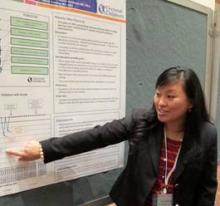COVINGTON, KY. – A multifaceted intervention propelled probiotic prescriptions within 18 hours of admission from 1% to 100% among children admitted for acute gastroenteritis with diarrhea.
This was true regardless of their insurance status.
Moreover, the 100% prescribing rate was achieved within 6 weeks and has been sustained for 7 months, lead author Dr. Michelle Parker reported at Pediatric Hospital Medicine 2012.
"It’s definitely become culture," she said during the poster presentation.
A multidisciplinary team of hospital medicine attending physicians, nurse representative, and a research assistant at Cincinnati Children’s Hospital identified six key drivers they felt would increase inpatient prescribing of Lactobacillus rhamnosus GG (LGG) at admission. They were identification of eligible patients; adequate staff knowledge; prescriber buy-in; available and appropriate administration of LGG; immediate response to failure of prescribing; and process standardization.
One of the biggest game changers was to incorporate LGG as a default order within the acute gastroenteritis electronic order set, with the appropriate dose and frequency preselected, Dr. Parker said. The default order did not just happen, without the physician being aware, as prescribing physicians still had to click, enter LGG, and save the indication for its use.
The second key element was monitoring the electronic medical records each weekday for children with acute gastroenteritis, aged 2 months to 18 years, who were not prescribed LGG, and e-mailing their care team.
"We engaged them in a dialogue, not told them they had to [prescribe]," said Dr. Parker, with Cincinnati Children’s division of hospital medicine. "That gave them a chance to prescribe it if that was their intention and it was just forgotten, and it was also a good chance to further the education."
Education included reviewing the evidence on LGG and appropriate prescribing with hospital medicine attending physicians, residents and medical students, brief monthly reminders to residents and a campaign to private pediatricians with admitting privileges that included electronic information and signage in key areas of the hospital.
Before the intervention, however, the hospital had published its own evidence-based guideline in 2007, recommending consideration of probiotics. A Cochrane review of 63 studies in 8,014 infants and young children had also been published, showing that probiotics were safe and had a clear benefit in reducing the duration of diarrhea, although the size of the effect varied between studies (Cochrane Database Syst. Rev. 2010 [doi:10.1002/14651858.CD003048.pub3]).
So why then did the hospital have a 1% preintervention prescribing rate?
Dr. Parker admits the 1% rate is "far less than ideal" but said other hospitals are likely in the same predicament because it’s very hard for people to put evidence and guidelines into practice.
"I think this is all around the country," she said. "There’s evidence that it takes 17 years of solid evidence to change practice, for it to become the expert recommendation."
The intervention also removed a logistic barrier, with the help of its pharmacy, which began supplying the community hospital inpatient unit with LGG, specifically adult Culturelle because it has the most evidence behind it, she said.
The labor-intensive identification and mitigation process was discontinued after the system stabilized and the focus of the initiative shifted more towards shared decision-making with families.
"Instead of saying you have to do this in all kids, we tell them it’s something they have to pay for out of pocket and that it’s a modest benefit of 24 hours of less stool," Dr. Parker said. "So, is that something you’re interested in doing?"
A separate analysis found that there was no difference in prescription fill rates based on insurance status. One explanation for this is that the pharmacy will dispense only the number of capsules prescribed, rather than having families pay for the entire bottle, which can cost between $17 and $30, she said.
The chart review excluded children with known or presumed bacterial gastroenteritis, major comorbid conditions, and former premature infants not yet 2 months corrected gestational age. Specific demographics on the cohort were not provided.
The authors acknowledged that the James M. Anderson Center for Health Systems Excellence in Cincinnati collaborated in the project.


